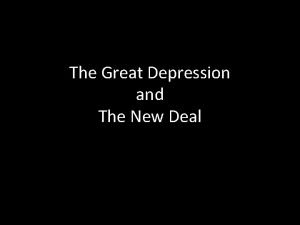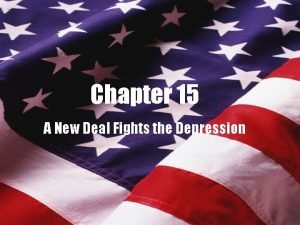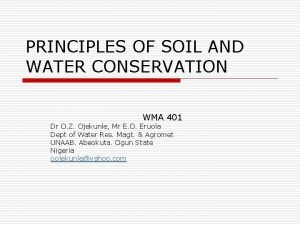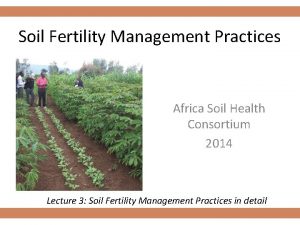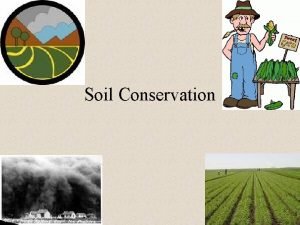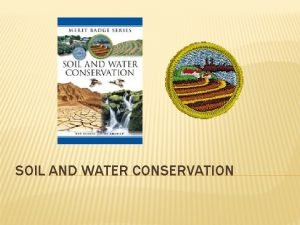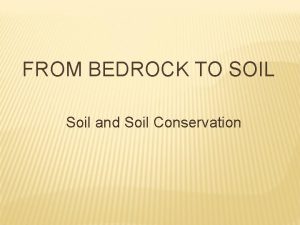Soil Conservation Soil conservation is the management of






![Soil Conservation George Washington Carver (January 1864[1][2] – January 5, 1943), was an American Soil Conservation George Washington Carver (January 1864[1][2] – January 5, 1943), was an American](https://slidetodoc.com/presentation_image_h2/436efe8ecbacd3584a83f8be1d3b84fa/image-7.jpg)

- Slides: 8

Soil Conservation Soil conservation is the management of soil to prevent its destruction. Soil can be conserved through: A), B) and C). contour plowing A)__________ Contour plowing farmers plow their fields along the curves of a slope. This helps slow the runoff of excess rainfall and prevents it from washing soil away.

Soil Conservation conservation plowing B) __________ (first plowing) conservation plowing farmers disturb the soil and its In __________ plant cover as little as possible. Deadweeds and stalks of the previous year’s crop are left in the ground to help return soil nutrients, retain moisture, and hold soil in place. This method is also called low-till or no-till plowing.

Soil Conservation In crop rotation C) _________ a farmer plants different crops in a field each year. Different types of plants absorb different amounts of nutrients from the soil. The farmer sows legumes such as alfalfa or beans to restore the nutrient supply

Soil Conservation

The Dust Bowl The dust bowl primarily hit western Kansas, Oklahoma, and parts or Colorado, New Mexico and Texas. These Prairie Soils were thick and rich in humus or very fertile. The – ______________ sod - thick mass of tough roots at the surface of the soil-kept the soil in _________ place and held onto moisture.

Soil Conservation A natural resource__________________. is anything in the environment that humans use Soil is one of Earth’s most valuable natural resources because everything that lives on land, including humans, depend directly or indirectly on soil. Fertile soil is valuable because there is a limited supply. The thick fertile soil of the prairies took many thousands of years to develop. The value of soil is reduced when soil loses its fertility and when topsoil is lost due to erosion. Loss of fertility – Soil that has lost its fertility is said to be exhausted. This happened in the South in the late 1800 s in farms where only cotton had been grown. Peanut plants are legumes. Legumes have small lumps on their roots that contain nitrogen-fixing bacteria in a form plant can use.
![Soil Conservation George Washington Carver January 186412 January 5 1943 was an American Soil Conservation George Washington Carver (January 1864[1][2] – January 5, 1943), was an American](https://slidetodoc.com/presentation_image_h2/436efe8ecbacd3584a83f8be1d3b84fa/image-7.jpg)
Soil Conservation George Washington Carver (January 1864[1][2] – January 5, 1943), was an American scientist, botanist, educator and inventor. Much of Carver's fame is based on his research into and promotion of alternative crops to cotton, such as peanuts and sweet potatoes. He wanted poor farmers to grow alternative crops both as a source of their own food and as a source of other products to improve their quality of life. Legumes contain lumps on roots that make nitrogen, an important nutrient. At work in laboratory

The Dust Bowl The Grapes of Wrath is a novel published in 1939 and written by John Steinbeck, who was awarded the Pulitzer Prize in 1940 and the Nobel Prize for Literature in 1962. Set during the Great Depression, the novel focuses on a poor family of sharecroppers, the Joads, driven from their Oklahoma home by drought, economic hardship, and changes in the agriculture industry. In a nearly hopeless situation, they set out for California along with thousands of other "Okies" in search of land, jobs and dignity. The Grapes of Wrath is frequently read in American high school and college literature classes. A celebrated Hollywood film version, starring Henry Fonda and directed by John Ford, was made in 1940; the endings of the book and the movie differ greatly.

